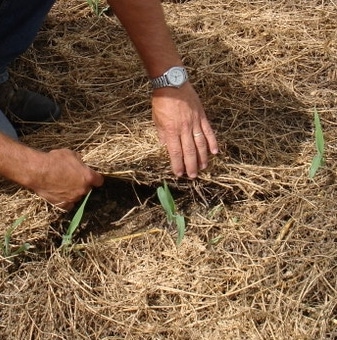Plowing causes serious problems in our ecosystems. Erosion (loss of soil itself) and soil degradation (loss of nutrients and soil compaction) are two significant problems that affect localized fields and areas downstream. But plowing also releases large amounts of greenhouse gases into the atmosphere; this is a global challenge. Now more than ever before, people recognize these disadvantages. Yet farmers continue to plow (as we humans have done for millennia). That’s because plowing does some important work in the agricultural process.

Plowing provides two primary advantages to farmers. 1) It upends plants (often called weeds) that would otherwise interfere with the growth of the new crop. 2) Plowing also opens the moist, nutrient rich soil where seeds can germinate.
Image from https://iowaagliteracy.wordpress.com/2015/04/27/why-do-they-do-that-plowing-or-tilling-fields/.
If farmers want to avoid or alleviate the negative drawbacks to plowing, they must figure out how to simulate its benefits. Farmers need ways to decrease the presence of unwanted plants that compete for nutrients, water, and light, and they need new technologies that help them place the desired seeds or seedlings into the nourishing soil without plowing. These tactical questions have captured the attention of many agronomists and farmers in recent decades.
The advent of agricultural chemicals (such as herbicides) has enabled scientists to develop one set of solutions. With the help of chemicals (such as glyphosate, the primary active ingredient in Roundup®) that kill vulnerable plants, farmers can now spray fields to kill unwanted plants and thereby avoid plowing. The weeds and other unwanted plants in the field die, making way for a new generation of seeds and seedlings to grow. This method of farming is called no-till conventional agriculture or is sometimes named conservation agriculture (because it focuses on conserving the soil).
With the weed problem out of the way, how do farmers open the ground so that new seeds can germinate in the moist soil? In the words of geologist David Montgomery, “No-till farmers . . . use specialized planters that open a narrow slot in the soil about the width of a kernel of corn. Seeds drop down into the slot, disturbing much less of the surrounding soil than plowing it up would.”[1] Along with this seed drill, innovative people have created equipment that “injects a uniform amount of fertilizer adjacent to and below each just-planted seed, putting nutrients right where plants need them—and only there. This uses far less fertilizer than spraying it all over the field. The farmer saves money and fewer chemicals run off to pollute streams, lakes, and oceans. That sounds like a win-win, except of course to fertilizer companies.”[2] This approach to agriculture greatly improves soil structure, reduces soil erosion and the release of greenhouse gases, retains moisture in the soil, and even reduces fertilizer run-off.
Of course, the big drawback to conventional no-till agriculture is its use of herbicides. I’ll present recent scientific findings on the effects of glyphosate on soil microbes and macrobes, insects, amphibians, birds, and mammals in future posts.
A less deadly no-till method of farming exist. Let’s consider it.
Image from http://clipart-library.com/pictures-of-poison.html.

No-till organic agriculture would appear to some to be doomed for failure since no synthetic agro-chemicals (such as herbicides) are used to kill and control weeds. But innovative farmers have developed new solutions for controlling weeds. In the fall, they plant a cover crop, such as rye or vetch, to out-compete weeds and to add nutrients and organic matter to the soil.

In the spring, farmers use a special roller-crimper that breaks the stems of the cover crop, killing the plants and laying them flat on the ground.[3] Farmers then use a seed drill to plant crop seeds into the soil underneath the layer of plant mulch (left-over from the cover crop; see image) that helps the soil absorb and maintain moisture and discourages the growth of weeds.[4] The organic no-till approach requires farmers to time their rolling-crimping perfectly so that the cover crop plants actually die but also before these plants produce viable seeds (that could then grow as competitors to the crop plants).
Image from https://www.ecofarmingdaily.com/build-soil/tillage/book-week-organic-no-till-farming/.
Both conventional and organic no-till systems enable farmers to implement three “best practices” that support long-term soil health and nutritious food. These practices include “minimum disturbance of the soil;” “growing cover crops and retaining crop residue so that the soil is always covered;” and “use of diverse crop rotations.”[5]
While I applaud the soil-conserving-achievements of conventional no-till farming, I believe scientists have collected enough data on the negative effects of glyphosate and other herbicide ingredients to give us pause. Farmers, consumers, politicians, and even agri-business employees should take a good, hard look at the data and reconsider whether conventional no-till methods—with its dependence on deadly chemicals—should be maintained. We’ll consider the evidence against glyphosate soon!
Please join my list of friends!
Get new content delivered directly to your inbox.
[1] David R. Montgomery, Growing a Revolution: Bringing Our Soil Back to Life (New York: W. W. Norton & Company, 2017), 22.
[2] Ibid.
[3] The Rodale Institute developed the roller-crimper. https://rodaleinstitute.org/why-organic/organic-farming-practices/organic-no-till/
[4] https://www.no-tillfarmer.com/articles/6497-cover-crops-can-make-organic-no-till-work
[5] Montgomery, 68.